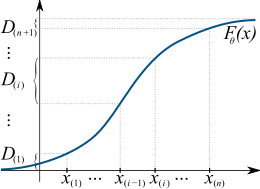
In statistics, maximum spacing estimation (MSE or MSP), or maximum product of spacing estimation (MPS), is a method for estimating the parameters of a univariate statistical model.[1] The method requires maximization of the geometric mean of spacings in the data, which are the differences between the values of the cumulative distribution function at neighbouring data points.
The concept underlying the method is based on the probability integral transform, in that a set of independent random samples derived from any random variable should on average be uniformly distributed with respect to the cumulative distribution function of the random variable. The MPS method chooses the parameter values that make the observed data as uniform as possible, according to a specific quantitative measure of uniformity.
One of the most common methods for estimating the parameters of a distribution from data, the method of maximum likelihood (MLE), can break down in various cases, such as involving certain mixtures of continuous distributions.[2] In these cases the method of maximum spacing estimation may be successful.
Apart from its use in pure mathematics and statistics, the trial applications of the method have been reported using data from fields such as hydrology,[3] econometrics,[4] magnetic resonance imaging,[5] and others.[6]
